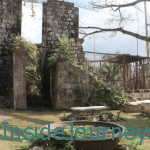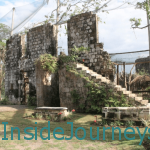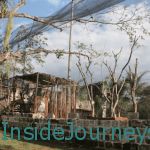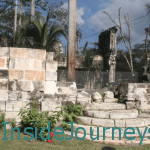When I heard there was a Slave Hospital at Good Hope Plantation in Trelawny, I was eager to see it. At that point, I didn’t know of another plantation that had its own hospital.
Now mostly in ruins, the remains of the 300-bed hospital, which was built around 1798, suggest a large building that was designed in almost the same Georgian style as the others at Good Hope.

Good Hope Great House & Plantation, one of Jamaica’s largest, was owned by John Tharp, whose holdings at the time of his death in 1804, were valued at approximately $4 million dollars, including 2,800 enslaved. Next to the hospital, Tharp also established a Free School for children who showed promise. A doctor also lived on the estate.
Tharp, who was born in Hanover, Jamaica, was 23 years old when he purchased Good Hope in 1767 from Thomas Williams. He treated his slaves well, making sure they were clothed, fed and housed.
My negroes have increased and are happy. They kill me with their constant visits and attentions. It gives pleasure, though I am fatigued to death before the day is half gone for I must talk and shake hands with every one of them.
That’s not to say that they were free. They were disposable property that were listed among his livestock with a value next to their names. But it’s his making available basic needs that earned their loyalty and explains why Good Hope remained untouched during revolts that destroyed other plantations. Good Hope continued to prosper even after the abolition of the trade in 1838. The sugar estate on the property remained in operation until 1902.
Only parts of the walls and steps of the Slave Hospital remain. The current owners is use it as an aviary.
Linking up this week with Travel Photo Thursday, which Nancie at Budget Travel Sandbox organizes. Be sure to head over and check out more photos from locations around the world.














Sad and beautiful…
I have to plead ignorance to knowing anything about slavery in Jamaica. This was a fascinating and enlightening read for me. Not that it would ever make slavery right, but nice to read of a plantation owner that treated slaves relatively well. Thanks for linking up this week!
Marcia, what an amazing story! While the mere word, slavery, gives me chills I am glad that at least this ‘owner’ (another detestable word) was concerned about health and education. A most interesting post.
300 beds! That is a huge hospital for just the slaves of a plantation. That statistic made me realize how big it must be. It’s not often that I hear about an owner establishing a school for slave children. But I wonder, what did they do with that education when they grew up? I hope the plantation owners were as kind to the workers once they were freed.
How fascinating. This kind of history though gives me goosebumps. We went to watch 12 Years a Slave at the cinema the other day – it was absolutely gut wrenching. I walked out of the movie a wreck!
Wow Marcia! I had no idea. Thank you for the history and the great photos.
A very interesting post Marcia, I can imagine those walls resounding in echoes of a lot many slaves in them!
So true, Arti. I hadn’t thought of that while I was there but I’m sure if I listened closely, I’d probably have heard them.
You’re welcome, Maria!
A story worth telling, Johanna, but it sure does pack a punch. It made me feel quite angry and frustrated.
That’s a good question, Michele. I wondered the same thing myself but haven’t been able to think of an answer.
It probably made them feel better about themselves but there weren’t many opportunities for them to use it.
There are at least two that I know of in Jamaica, Jackie. It worked out well for them as their properties were not touched when the enslaved revolted.
Thanks, Nancie. This part of Jamaica’s history is fascinating to me too.
Your linkup is fun. I look forward to it each week.
This is both sad and interesting history. I can’t believe how large this hospital and plantation was. It is a bit of a relief that the slaves were taken care of no matter what the owner’s intentions may have been.But, it does show that with some goodness came a great reward of loyalty. Thanks for sharing such a special place of history.
Hi Marcia, the history of slavery is always a heartbreaking subject for me. It’s good to know that there were good estate owners who treated their slaves humanely. The fact that Tharp built a hospital for his slaves showed that he was more caring than most owners at that time. I was amazed at the number of beds at the hospital – I thought 300 was a lot until I realized that Tharp actually had 2,800 of them. Interesting post.
What a story! It’s hard to believe that one man had 2800 slaves but nice to hear that he looked after them with a hospital and school. Fascinating!
A very interesting post that gives a another perspective of slavery. I would also be interested in learning about the slaves in Jamaica such as the maroons who rebelled and formed their own independent communities.
Wow, this is definitely not part of Jamaica’s history I knew anything about. Thanks so much for sharing and educating, Marcia.
You’re welcome, Jess!
I’d be happy to share some information on the Maroons with you, Rachel.
There’s a new documentary called Akwantu. I think you can probably get it on DVD now.
Tharp was one of, perhaps the richest, plantation owner in Jamaica.
In addition to the slaves, he had almost 9000 acres.
Thanks Marisol & Keith. It’s a very heartbreaking and sad part of life, part of history.
Sometimes I wish there could have been more people who found it heartbreaking enough not to engage in it at all.
You’re welcome, Mary. The plantation as it is now is about 2000 acres, still quite large.
Tharp was a special man, for sure.
Thanks Marcia, I’ve checked the trailer on youtube, and i’ll see how I can get the dvd. I am aware there are many untold triumphant and inspiring slave narratives.
Here’s an interesting documentary, Dana Carmel’s recommended to me “They are We”.
It is about young girl named Josefa, who was taken away from Sierra Leone as part of the transatlantic trade to Cuba in the 1830’s. Josefa held her village’s songs and dances in her heart. Captured in Africa, she treasured them as she was loaded into the gruesome hold of a slave ship and then sold as a beast of burden in Cuba. Toiling on a plantation, she taught the songs and dances to her children and grandchildren, words and rhythms. One of her great granddaughter Florinda in turn taught her grandson, whom she raised from infancy. He is Humberto Casanova, now himself a great-grandfather. It is Casanova and three of his friends who visit Josefa’s village in Sierra Leone to re connect with their long lost ancestors.
I love ruins. It reflects the historical beauty of Jamaica
Let me know if you’re able to get a copy. Let me know if you want me to put you in touch with the film maker.
Yes, there are! I read of the Cuba story sometime ago. It’s quite touching. If only more of us could make the connection.
Ruins and Jamaica never really mixed in my mind. Now they do 🙂 Btw I also just followed you on Twitter. Great blog! Looking forward to connect!
We’re better known for our beaches but we actually have quite a few ruins as well.
Thanks and thanks for following me on Twitter. Glad you like my blog.